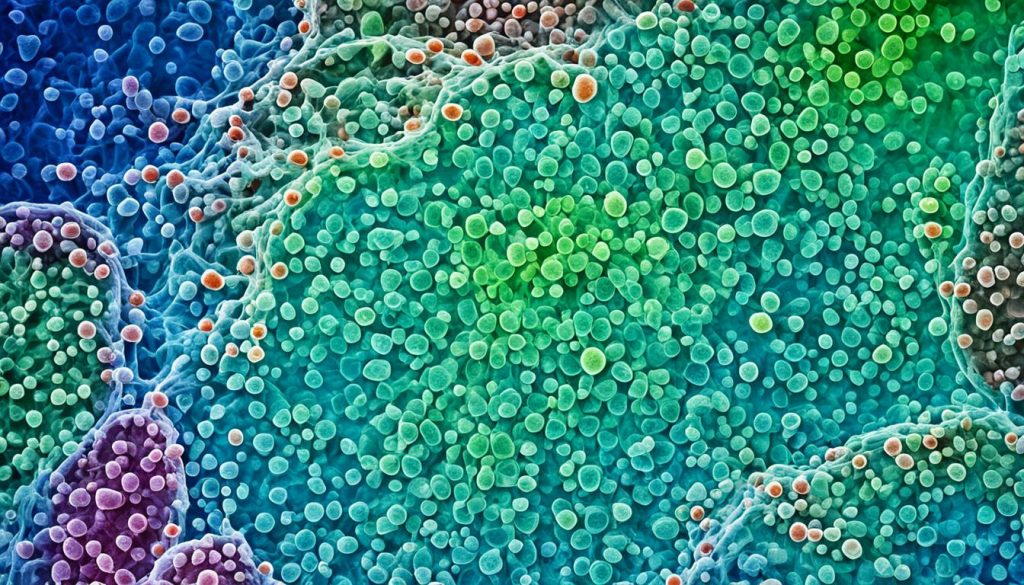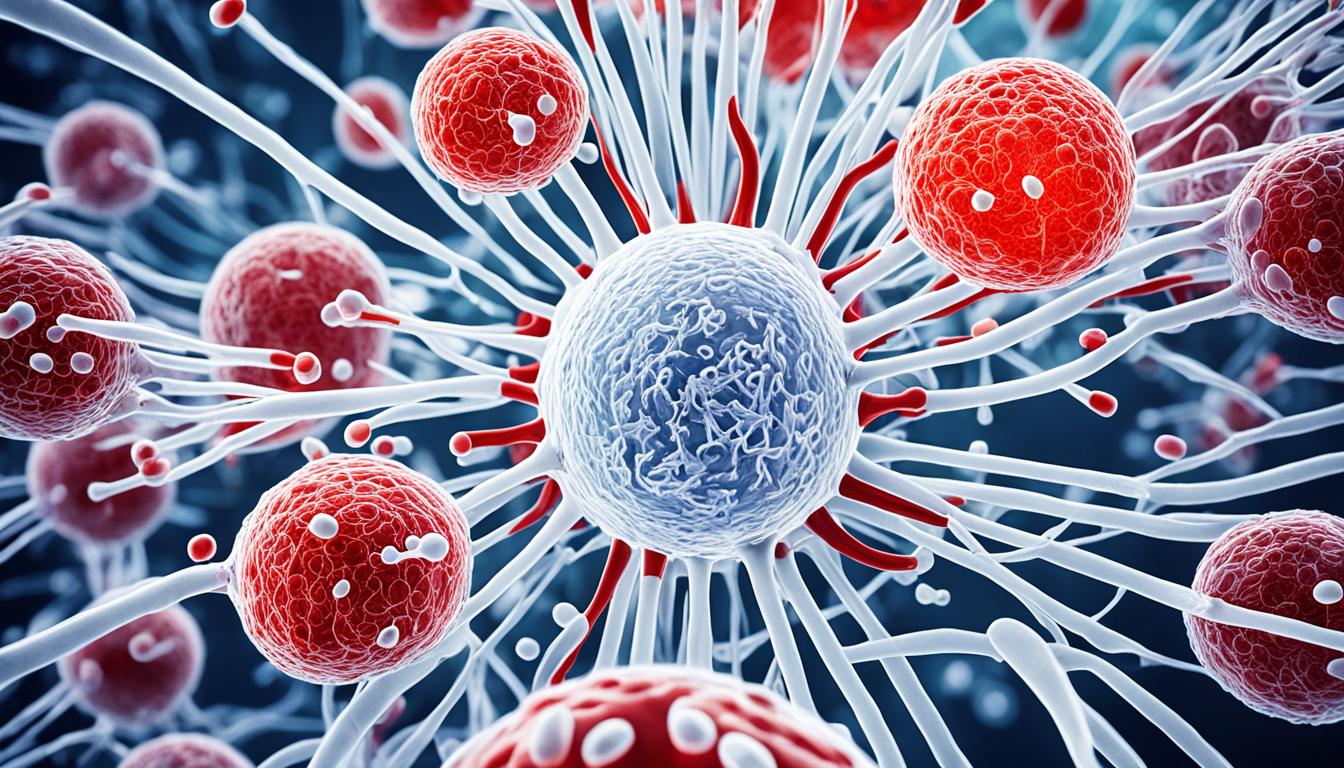IgA nephropathy, called Berger’s disease, happens when the antibody immunoglobulin A (IgA) builds up in the kidneys. This buildup causes inflammation, making it hard for kidneys to clean the blood properly. People with this problem might notice blood and protein in their urine, have high blood pressure, and see swelling in their feet.
Stem cell therapy offers new hope for treating IgA nephropathy. It can slow the disease and help kidneys work better. Although there’s no cure, certain medicines can control symptoms and slow down the disease. In the worst cases, a kidney transplant might be the only option.
Key Takeaways:
- IgA nephropathy, or Berger’s disease, is a kidney syndrome caused by immunoglobulin A (IgA) buildup in the kidneys.
- People with this condition may find blood and protein in their urine, experience high blood pressure, and notice swelling in their feet.
- Stem cell therapy can help by encouraging the growth of kidney cells and making the kidneys work better.
- While medicines can ease symptoms and slow its spread, there’s no actual cure for IgA nephropathy.
- In severe situations, one might need a kidney transplant.
Diagnosis and Causes of Berger’s Disease
To diagnose Berger’s disease, doctors use both clinical evaluation and tests. They check for IgA deposits and signs in blood and urine. These tests are critical for diagnosis. A kidney biopsy may also be done to see how much damage is there. Tests like the Allen test and angiogram check for blocked arteries.
The cause of Berger’s disease is still unknown. However, it’s thought to be from genetics and immune problems. Smoking is also linked to getting and worsening this disease.
Diagnostic Tests for Berger’s Disease
Many tests help diagnose Berger’s disease. Each one provides essential information:
- Kidney Biopsy: A small piece of kidney tissue is taken to check for IgA deposits and damage.
- Blood and Urine Tests: These identify IgA deposits and signs of kidney issues, helping confirm the disease.
- Allen Test: This checks blood flow in hands or feet for potential problems.
- Angiogram: Uses X-rays to see blood vessels and find any blockages.
These tests together confirm Berger’s disease by showing IgA deposits and kidney damage.
Possible Causes of Berger’s Disease
While we don’t know the exact cause of Berger’s disease, genetics and immune problems are likely factors. IgA deposits cause inflammation and kidney damage over time.
Some key factors might trigger this disease:
- Genetics: Certain genes increase the risk of getting Berger’s disease.
- Immune System Abnormalities: Problems with the immune system can cause IgA deposits in the kidneys.
- Smoking and Tobacco Use: There’s a strong connection between smoking and the start and worsening of the disease.
Knowing these causes helps doctors diagnose and treat Berger’s disease better.
| Diagnosis | Causes |
|---|---|
| IgA deposits | Genetic factors |
| Blood and urine tests | Immune system abnormalities |
| Kidney biopsy | Smoking and tobacco use |
Symptoms and Treatment of Berger’s Disease
Berger’s disease, or IgA nephropathy, shows different symptoms based on how the kidneys are affected. You might find blood or protein in the urine, experience high blood pressure, or see swelling in your hands and feet. Sometimes, people don’t know they have it until a urine test shows something’s off.
When treating Berger’s disease, the goal is to lessen symptoms, slow the disease, and keep the kidneys working. Treatment includes many strategies. For example:
- Medications: Doctors prescribe meds to lower blood pressure and reduce protein in the urine. This helps slow kidney damage.
- Lifestyle changes: Eating right, managing your weight, and stopping smoking can really help your kidneys. These changes also control blood pressure.
- Immunosuppressive therapy: If the disease gets worse, this therapy helps a lot. It calms the immune system and decreases kidney swelling.
- Dialysis: In serious cases, when kidneys hardly work, dialysis is needed. It cleans the blood from waste and extra fluid.
- Kidney transplantation: In the worst cases, a new kidney is the best solution. It brings back kidney function.
New research in regenerative medicine shows hope for treating Berger’s disease in new ways. Stem cell therapy is a standout treatment, looking to better kidney function and stop the disease.

Stem cell therapy uses special cells to fix and grow new kidney tissue. These stem cells send out healing signals, making healthy kidney cells grow. Studies prove that this therapy improves kidney work and reduces swelling in people with Berger’s disease.
| Treatment Options for Berger’s Disease | Benefits |
|---|---|
| Medications | Control blood pressure, reduce proteinuria, and manage inflammation |
| Lifestyle changes | Improve overall kidney health and manage high blood pressure |
| Immunosuppressive therapy | Suppress the immune system’s response and reduce inflammation in the kidneys |
| Dialysis | Filter waste and excess fluids from the blood in advanced cases |
| Kidney transplantation | Restore kidney function in end-stage kidney disease |
| Stem cell therapy | Promote the growth of new, healthy kidney cells and improve renal function |
For those considering a new approach to treating Berger’s disease, stem cell therapy is an option. Stem Cell Care India offers this innovative treatment. They aim to enhance patient health with tailored treatment plans.
Stem Cell Therapy for Berger’s Disease: Treatment Procedure and Benefits
Stem cell therapy is a powerful tool against Berger’s disease. It uses stem cells injected into the body. These cells help heal kidney damage by releasing growth factors and proteins.
The first step in stem cell therapy is a detailed evaluation. Doctors examine patients to understand the condition’s severity. Then, they inject stem cells into specific body areas to start healing.
Alongside stem cell injections, patients may receive other supportive treatments. These extra therapies boost the stem cells’ work. Also, physical therapy might be included to help strengthen the body during recovery.
The results of stem cell therapy for Berger’s disease are impressive. It improves kidney function, giving patients a better life. It also reduces inflammation, easing Berger’s disease symptoms.
One amazing benefit is how it slows the disease’s progress. By regenerating kidney cells, stem cell therapy tackles Berger’s disease at its root. It offers a forward-thinking, comprehensive treatment method.
Stem Cell Care India provides top-notch stem cell therapy for Berger’s disease. Their seasoned doctors and cost-effective treatments ensure the best care. Patients enjoy significant therapeutic gains at this leading clinic.
Conclusion
Berger’s disease, also known as IgA nephropathy, is a kidney disease. It’s marked by immunoglobulin A (IgA) in the kidneys. Although no cure exists, treatments can manage symptoms and slow the disease. Medications help with hematuria, proteinuria, and high blood pressure.
Stem cell therapy has become a hopeful alternative for Berger’s disease. It can improve kidney function and stop the disease from getting worse. The therapy injects stem cells into the body. These cells then release substances that help repair kidney cells. This therapy is a new beacon of hope for patients.
If you or someone you care for has Berger’s disease, stem cell therapy could be worth exploring. Stem Cell Care India is a leading clinic in this field. They offer expert doctors and treatments that are affordable. They aim to help kidneys heal and improve how patients feel. Look into stem cell therapy as a way to boost life quality for those with Berger’s disease.
FAQ
Q: What is Berger’s disease?
A: Berger’s disease is known as IgA nephropathy too. It’s a kidney condition. It happens when the antibody immunoglobulin A (IgA) builds up in the kidneys.
Q: What are the symptoms of Berger’s disease?
A: People with Berger’s disease often find blood and protein in their urine. They might have high blood pressure. Swelling in the feet is also common.
Q: How is Berger’s disease diagnosed?
A: Doctors diagnose Berger’s disease by looking at symptoms and doing tests. These tests include checking blood and urine. A kidney biopsy is also a key test.
Q: What causes Berger’s disease?
A: We don’t fully understand what causes Berger’s disease. It might be linked to genetic factors and immune system issues. Smoking and tobacco use can make it worse.
Q: What is the treatment for Berger’s disease?
A: Treating Berger’s disease aims to control symptoms and protect the kidneys. Treatment might include medicine. In serious cases, dialysis or kidney transplant may be needed.
Q: What is stem cell therapy for Berger’s disease?
A: Stem cell therapy treats Berger’s disease by injecting stem cells. These cells help repair kidney cells and improve how the kidney works.
Q: What are the benefits of stem cell therapy for Berger’s disease?
A: Stem cell therapy can make kidneys work better, lower inflammation, and stop the disease from getting worse.
Q: How does stem cell therapy work for Berger’s disease?
A: Stem cells help by releasing substances that repair damaged kidney tissue. This can make the kidneys function better for those with Berger’s disease.
Q: Where can I find stem cell therapy for Berger’s disease?
A: Stem Cell Care India offers effective stem cell therapy for Berger’s disease. They have skilled doctors and treatments you can afford.

